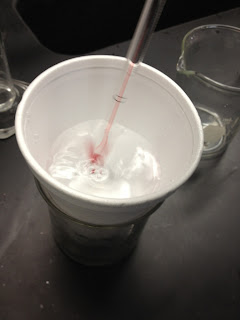(Partners: Victoria L.)
Observations:
 |
| Reaction 1 |
 |
| Reaction 2 |
 |
| Reaction 3 |
Calculations:

Sample
|
Mass of empty test tube
|
Mass of test tube plus KNO3
|
Mass of test tube plus KNO3 plus water
|
Saturation Temperature
| |
Series 1
|
A
|
8.76 g
|
9.21 g
|
10.26 g
|
50°
|
B
|
8.77 g
|
9.47 g
|
10.44 g
|
42°
| |
C
|
8.82 g
|
10.03 g
|
11.23 g
|
32°
| |
Series 2
|
A
|
18.95 g
|
19.31 g
|
20.32 g
|
32°
|
B
|
24.04 g
|
25.01 g
|
25.97 g
|
56°
| |
C
|
18.78 g
|
20.29 g
|
21.16 g
|
60°
| |
Time (min)
|
T (oC)
|
Time (min)
|
T (oC)
|
Time (min)
|
T (oC)
|
Time (min)
|
T (oC)
| ||
0
| 70 |
3.5
| 48 |
0
| 37 |
3.5
| 77 | ||
0.5
| 66 |
4.0
| 46 |
0.5
| 53 |
4.0
| 78 | ||
1.0
| 63 |
4.5
| 44 |
1.0
| 64 |
4.5
| 81 | ||
1.5
| 60 |
5.0
| 42 |
1.5
| 70 |
5.0
| 84 | ||
2.0
| 57 |
5.5
| 40 |
2.0
| 74 |
5.5
| 86 | ||
2.5
| 54 |
6.0
| 38 |
2.5
| 75 |
6.0
| 88 | ||
3.0
| 51 |
6.5
| 37 |
3.0
| 77 |
6.5
| 90 |